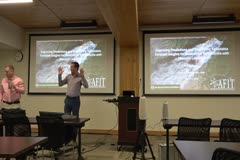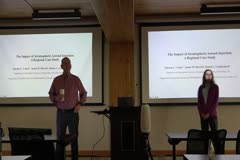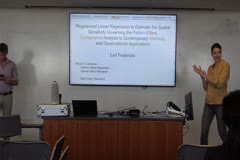Defenses for Spring 2025

Improving Predictions and Generating Actionable Forecast Insights for Downslope Windstorms with Machine Learning
March 11, 2025
Casey Zoellick
Downslope windstorms are an extreme weather phenomenon characterized by accelerating winds down the lee slope of a mountain with gusts often exceeding 45 m s-1. These impact society through damage directly related to the high winds, ground transportation concerns in the vicinity of the windstorm, aviation impacts through the accompanying mountain wave turbulence, and fueling the rapid…

March 10, 2025
Sabrina Cohen
Stratospheric aerosol injection (SAI) is a form of climate intervention that has been proposed to limit future warming and mitigate some of the adverse impacts of climate change while humanity continues efforts to reduce emissions and atmospheric concentrations of greenhouse gases. In this study, we use an Earth system model to compare the projected effects of a climate change scenario to…

Cold Pool Propagation and Cold Pool-Land Surface Interactions
February 24, 2025
Nicholas Falk
Convective cold pools are important components of the Earth system as they influence processes such as deep convective initiation, storm longevity and intensity, surface energy fluxes, and aerosol transport. The overarching goal of the research outlined in this dissertation is to investigate the propagation characteristics of cold pools, as well as the interactions between cold pools and the…

Comparison of Microphysical and Topographical Influences on Warm Season Storm Electrification Between Subtropical South America and Colorado
February 19, 2025
Mitchell Gregg
Sixteen years of observations from the Tropical Rainfall Measurement Mission (TRMM) satellite’s Precipitation Radar were key in identifying subtropical South America in the lee of the Andes as a global hotspot for convection, with frequent back-building over terrain producing intense convection yielding some of the highest lightning flash rates on Earth. These observations motivated the 2018…

Eulerian and Lagrangian Analyses of Bioaerosol Transport in Three Deep Convective Storm Morphologies
February 18, 2025
Charles Davis
In this thesis, we investigate the entrainment and transport of aerosol particles in a representative isolated deep convective storm, supercell, and squall line using idealized high-resolution mesoscale model simulations. We focus our investigation on the extent to which air from rainy surface regions, which have been noted in the literature to be sites of aerosolization of biological…

Data-Driven Improvements to GPROF-Based Satellite Snowfall Retrievals with a Focus on Mountain Snowfall
January 27, 2025
Ryan Gonzalez
Snowfall is a critical component of Earth's hydrological and climate system despite only 5% of Earth's annual precipitation falling as snow. Satellite-based snowfall estimates, particularly those obtained from the Global Precipitation Measurement (GPM) Microwave Imager (GMI), struggle to accurately estimate the total annual snowfall accumulations, especially in mountainous regions of the…

REGULARIZED LINEAR REGRESSION TO ESTIMATE THE SPATIAL SENSITIVITY GOVERNING THE PATTERN EFFECT, COMPARATIVE ANALYSIS TO CONTEMPORARY METHODS, AND OBSERVATIONAL APPLICATIONS
January 22, 2025
Leif Fredericks
How the spatially varying temperature field affects global radiation (i.e., the "pattern effect") is crucial to understanding how sensitive Earth’s temperature is to anthropogenic forcing. We capture this phenomenon in a sensitivity map using regularized linear regression. When trained on 1,000 simulated years in a climate model, the resulting sensitivity maps are consistently able to…
